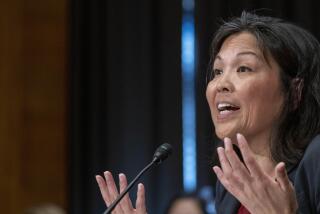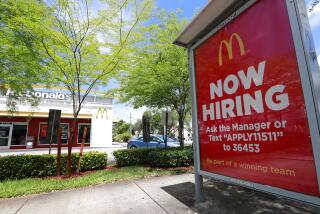Why Minimum Wage Produced Maximum Rift
- Share via
The wrangle between Congress and the White House over raising the minimum wage might be infuriating if it weren’t so confusing.
President Bush last week vetoed a bill to increase the nation’s lowest wage to $4.55 an hour from $3.35, where it has been since 1981. That doesn’t sound excessive at a time when McDonald’s is paying an average of $4.60 an hour for counter help, so it’s not surprising that the great majority of respondents to a Gallup Poll said they’d support a hike in the minimum wage. It’s like backing the underdog.
Yet the President said the $4.55 wage proposed by Congressional Democrats and organized labor was inflationary and would cost 400,000 jobs by discouraging hiring. So he vetoed it--and the Democrats charged that, far from being kinder and gentler, he was against the working poor.
But the issue is more complex than mean-spirited. One problem appears to be determining just who are the poor, and another is choosing the best way to help them lead fuller lives in American society.
The President said he would back a minimum wage of $4.25 an hour if it were coupled with a lower training wage for new hires in their first six months on the job. The avowed intention there is to encourage employers to keep on hiring. But it’s also a way of limiting the benefits going to teen-agers who work after school or during summer vacation, who make up a sizable proportion of minimum-wage earners.
Avoids Real Issues
Those teen-agers are one reason most economists say the minimum wage is a bad idea as a way of helping the poor. “You can’t take the position that the teen-ager in the fast food restaurant is a breadwinner, and therefore in need of a national program of help,” Nobel Prize-winning Yale economist James Tobin said.
Lawrence Summers, professor of economics at Harvard and an adviser to 1988 Democratic presidential candidate Michael S. Dukakis, said: “The fact is, current minimum-wage benefits are disproportionately going to kids and second earners” from relatively prosperous two-paycheck households.
And Daniel Mitchell, head of the Institute of Industrial Relations at UCLA, criticizes those who see the minimum wage as the solution to poverty. He said it avoids the real issues of why people earn low pay--issues such as poor education and lack of skills.
But why concentrate on teen-agers? Are there no adult poor people left in America? You bet there are. Of the 5.4 million workers earning the minimum wage, 50% are older than 25. That’s the world of single parents and troubled families. And beyond the minimum, another 10 million workers earn less than $4.49 an hour, or just under $9,000 a year, and the poverty level for a family of three is $9,431 a year.
Such workers earn less than half the U.S. average wage, and a tiny fraction of the huge incomes paraded these days by society’s winners--financiers and sports stars, corporate executives and entertainers. If it made sense to help bottom-rung wage earners 51 years ago, when the minimum wage first became law, doesn’t it make sense today?
Creating Jobs
Of course it does. But there are better ways than the minimum wage to help them, say economists--and many politicians, including President Bush. The method they favor is to expand the Earned Income Tax Credit, by which a low-income earner can get a super tax refund. That is, poor families with children can receive not only forgiveness of their tax liability but also a supplement to their income--up to $1,000 a year, under current law.
That beats the minimum wage, economist Summers said, because it’s an explicit tax on society’s better-off to help its less-well-off, rather than an implicit tax that hits employers and pushes prices higher.
The whole issue reflects not mean-spiritedness, but how America has changed since 1938, when the Fair Labor Standards Act first set a minimum wage--of 25 cents an hour.
The purpose of that law was to create jobs for male heads of households, explains UCLA’s Mitchell. The minimum wage was actually a minor feature in a law that set the work week at 40 hours and mandated time-and-a-half pay for overtime to encourage hiring. The law also placed restrictions on teen-agers working in factories or on construction sites, so that such jobs would be kept for heads of families.
Finally, the law covered only industrial workers. Employees of retail stores, who today make up about half the minimum wage earners, weren’t covered until 1961.
Okay, so the U.S. work force and economic conditions are much different today. Does that mean the poor will miss a raise because of a dispute between Congress and the President?
Happily, no. Late last week in Washington, compromise solutions were emerging, with members of Congress drafting legislation both to raise the minimum wage and expand benefits and coverage of the Earned Income Tax Credit. It’s likely that, before the year is out, something will be done to show that the system works--if slowly--and, more important, works for those who are not among its winners.
More to Read
Get the L.A. Times Politics newsletter
Deeply reported insights into legislation, politics and policy from Sacramento, Washington and beyond. In your inbox three times per week.
You may occasionally receive promotional content from the Los Angeles Times.










